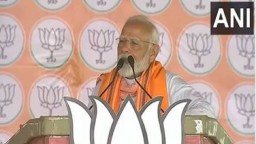Latest News
Indo-American Relations Warming Up: Russian and Chinese Angle

The recently released National Security Strategy by Biden administration emphasises India’s centrality in America’s Indo-Pacific strategy. It states India is world’s largest democracy and a major defence partner of the United States and the US will work with India both bilaterally and multilaterally, to support commonly shared vision of a free and open Indo-Pacific. The U.S. not only needs India in the Indo-Pacific, but would also like India to play a larger role in South, Central, and Southeast Asia. Indo-Pacific Quad (Australia, India, Japan, United States) the U.S.-EU Trade and Technology Council, AUKUS (Australia, United Kingdom, United States) and I2-U2 (India, Israel, UAE, United States) are all created by the US initiative to develop strong, resilient, and mutually reinforcing relationships to ensure world order for peace and development.
The year 2022 has been a remarkable and historic year for the India-US relationship, and 2023 is expected to be more momentous year for the ties between the world’s largest and oldest democracies that will determine the future of technology and innovation. The tangible outcomes like resolution of some old market access issues, the first-ever maintenance of a US Naval Ship in India, the Quad focus on STEM, signing of an Investment Incentive Agreement, the launch of Technology Innovation Hubs as a collaboration of the respective science agencies, record level of trade and investments have cemented the Indo US ties.
India’s close defence cooperation and strategic ties with Russia, stand on Ukraine war, abstention on U.N. votes condemning Russia and refusal to stop buying Russian oil and military equipment are definitely irritants for warming Indo US ties. However, India has unequivocally condemned the violence and called for the resolution of the conflict through dialogue and diplomacy. India also sent humanitarian aid to Ukraine. Despite all this, India still remains at the heart of the U.S. approach to its peer competition with China. The United States may not like India’s ties with Russia, but it seems willing to accept them as the necessary price for keeping India onboard in dealing with a rising China.
Russia has been a historically dependent ally and biggest supplier of defence equipment and trading partner with India. However, the Americans may be aiming to help India in case of possible military aggression from China by their support in meeting India’s defence needs and this will accelerate India’s transition away from weapons and defence systems manufactured in the Russia. Another issue is India’s historical preference for a multipolar world order and strategic autonomy which has kept it out of falling in any ‘Camp’. The United States is beginning to accept, India’s preference for multipolarity and its close relationship with Russia. While complete detachment from Russia is impossible, India has certainly prioritised those of its strategic interests that require closer cooperation with the Western countries.
China is like an urgent threat but a necessary partner for India. Despite clashes on LAC the bilateral trade is up and India has been reluctant to have any direct confrontation with China. Constant security threats from China and Pakistan imply that it would take time for India to diversify its defence imports and also increase indigenous production of arms. Rather Indo- US proximity discomforts China and it will definitely put every kind of pressure on India to keep out of American influence. Russia who is biggest exporter of defence equipment to India may be a possible Chinese card to seek normalisation of India-China relations as this not only benefits global and Asian security but keeps the US domination under control.
India has to stand up to China without being belligerent charting its own course even as it draws close to the United States, Europe and Australia. For the United States, the Indian imperative to stand up to China continues to present an opportunity for deepening cooperation. The United States and India have a common cause in their tensions with China, as well as a “natural partnership” on technology investments. In assuming the presidencies of both the G-20 and the Shanghai Cooperation Organization (SCO), India is set to host leaders from across the globe in 2023. As India prepares for general elections in 2024, it may be increasingly sensitive to global perceptions of how it handles possible shocks - external or internal - ranging from escalation on its borders to incidents of communal violence.
China with a tag of regional hegemon and a strong ally of Pakistan has emerged as the most important perceived threat to Indian interests in South Asia. Russia remains India’s most dependable partner for its defence and energy needs. But the possibility of Russia playing junior partner of China at the end of Ukraine war to counter NATO and US threat leaves India with little options but to respond warmly to US initiatives to rope in India as not only security partner of first resort but to be the premier partner in India’s extraordinary growth story.
THE VIEWS EXPRESSED BY THE AUTHOR ARE PERSONAL
COL RAJESH BHUKAR The author is a Post Graduate in International Studies, Alumni of Defense Services Staff College, Wellington and College of Combat, Mhow [email protected]








.png)






.png)




.png)
